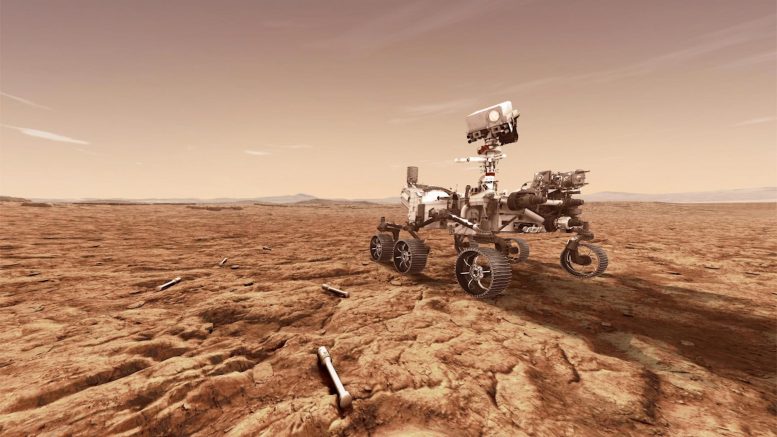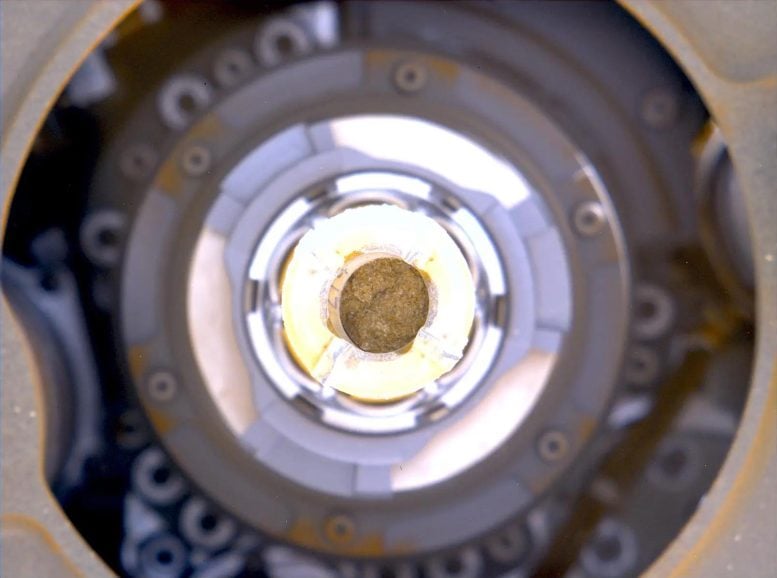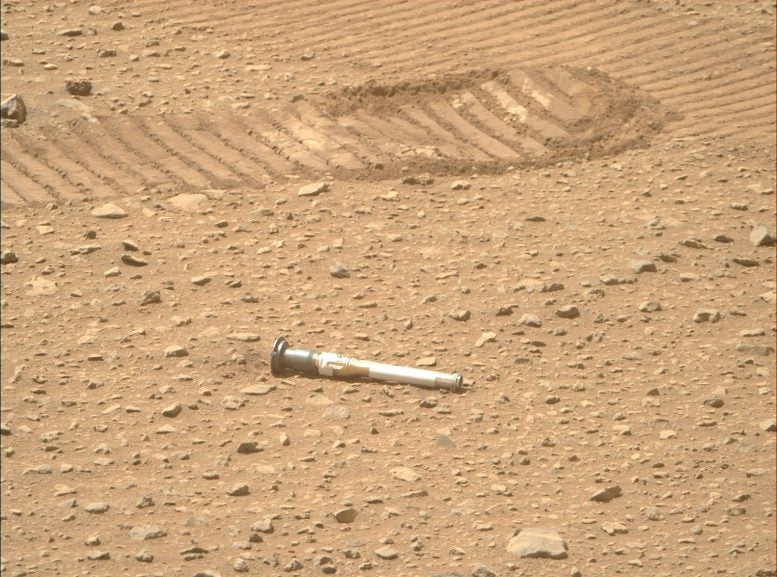
NASA’s Mars Perseverance rover stores rock and soil samples in sealed tubes on the planet’s surface for future missions to retrieve, as seen in this illustration. Credit: NASA/JPL-Caltech
Enclosed with any rock and soil samples collected from NASAThe Perseverance rover is a potential boon for atmospheric scientists.
NASA persistence March The rover is collecting samples on Mars, including rock cores and atmospheric gases, to eventually return to Earth. These samples could provide critical insights into the Martian atmosphere and its evolution, possibly revealing the presence of microbial life billions of years ago. Gas samples, in particular, can provide valuable clues about the planet’s ancient climate and trace gases, drawing parallels with Earth’s atmospheric history and aiding future manned missions to Mars.
Mars sample collection
With every rock core that NASA’s Mars Rover Perseverance seals in its titanium sample tubes, atmospheric scientists get a little more excited. These samples are being collected for eventual delivery to Earth as part of the Mars Sample Return campaign, with twenty-four taken so far.
Most of these samples consist of rock cores or regolith (broken rock and dust) that can reveal important information about the planet’s history and whether microbial life was present billions of years ago. But some scientists are just as excited by the prospect of studying the “head space,” or air in the extra chamber around the rock material, in the tubes.
They want to learn more about the Martian atmosphere, which is made up mostly of carbon dioxide but can also include small amounts of other gases that may have been around since the planet formed.

This image shows a rock core about the size of a piece of chalk in a sample tube placed inside NASA’s Perseverance Mars Rover drill. Once the rover closes the tube, air will be trapped in the extra space in the tube – seen here in the small gap (called “headspace”) above the rock. Credit: NASA/JPL-Caltech/ASU/MSSS
Insights from the Martian Headspace
“Air samples from Mars would tell us not only about the current climate and atmosphere, but how it has changed over time,” said Brandi Carrier, a planetary scientist at NASA’s Jet Propulsion Laboratory (JPL) in California. Southern. “It will help us understand how climates different from our own evolve.”
Among the samples that may be brought back to Earth is a tube filled only with gas deposited on the surface of Mars as part of a sample repository. But much more of the gas in the rover’s collection is within the main rock sample space. These are unique because the gas will interact with the rock material inside the tubes for years before the samples can be opened and analyzed in laboratories on Earth. What scientists glean from them will provide insight into how much water vapor hovers near the Martian surface, a factor that determines why ice forms where it does on the planet, and how the Martian water cycle has evolved over time.

A sealed tube containing a sample of the Martian surface collected by NASA’s Mars Perseverance rover is seen here, having been deposited with other tubes in a “sample repository.” Other sample-filled tubes are stored inside the rover. Credit: NASA/JPL-Caltech
Comparison of trace gases and ancient atmospheres
Scientists also want a better understanding of trace gases in the air on Mars. More scientifically appealing would be the discovery of noble gases (such as neon, argon, and xenon), which are so unreactive that they may have been around, unchanged in the atmosphere, since formation billions of years ago. If captured, these gases could reveal whether Mars began with an atmosphere. (Ancient Mars had a much thicker atmosphere than it does today, but scientists aren’t sure if it was always there or if it developed later.) There are also big questions about how the planet’s ancient atmosphere compares to that of the early Earth.
The space probe would also provide a chance to assess the size and toxicity of dust particles — information that will help future astronauts on Mars.
“The gas samples have a lot to offer Mars scientists,” said Justin Simon, a geochemist at NASA’s Johnson Space Center in Houston, who is part of a group of more than a dozen international experts helping decide which samples the rover should collect. “Even scientists who don’t study Mars would be interested because it will shed light on how planets form and evolve.”
Apollo air samples
In 2021, a group of planetary researchers, including scientists from NASA, studied the air brought from the Moon in a steel container by the Apollo 17 astronauts about 50 years ago.
“People think of the Moon as airless, but it has a very thin atmosphere that interacts with lunar surface rocks over time,” said Simon, who studies a variety of planetary samples at Johnson. “This includes noble gases flowing from the interior of the Moon and accumulating on the lunar surface.”
Laboratory techniques for gas analysis
The way Simon’s team extracted the gas for study is similar to what could be done with Perseverance’s air samples. First, they place the previously unopened container in an airtight seal. Then they pierced the steel with a needle to draw the gas into a cold trap—essentially a U-shaped tube that lies in a liquid, like nitrogen, with a low freezing point. By changing the temperature of the liquid, the scientists trapped some of the gases with lower freezing points at the bottom of the cold trap.
“There are probably 25 labs in the world that manipulate the gas in this way,” Simon said. In addition to being used to study the origin of planetary materials, this approach could be applied to gases from hot springs and those emitted from the walls of active volcanoes, he added.
Of course, those sources offer much more gas than Perseverance has in its sample pipelines. But if a single tube doesn’t carry enough gas for a particular experiment, Mars scientists can combine gases from multiple tubes to get a larger total sample—another way the main space offers a bonus opportunity for science. .
NASA’s Mars Persistence Rover
NASA’s Perseverance rover, part of the Mars 2020 mission, is a sophisticated mobile laboratory designed to explore the surface of Mars. Launched on July 30, 2020, and landing on Mars on February 18, 2021, at Jezero Crater, Perseverance has a primary mission to search for signs of ancient life and collect samples of rocks and regolith (broken rock and soil) for return to possible on Earth.